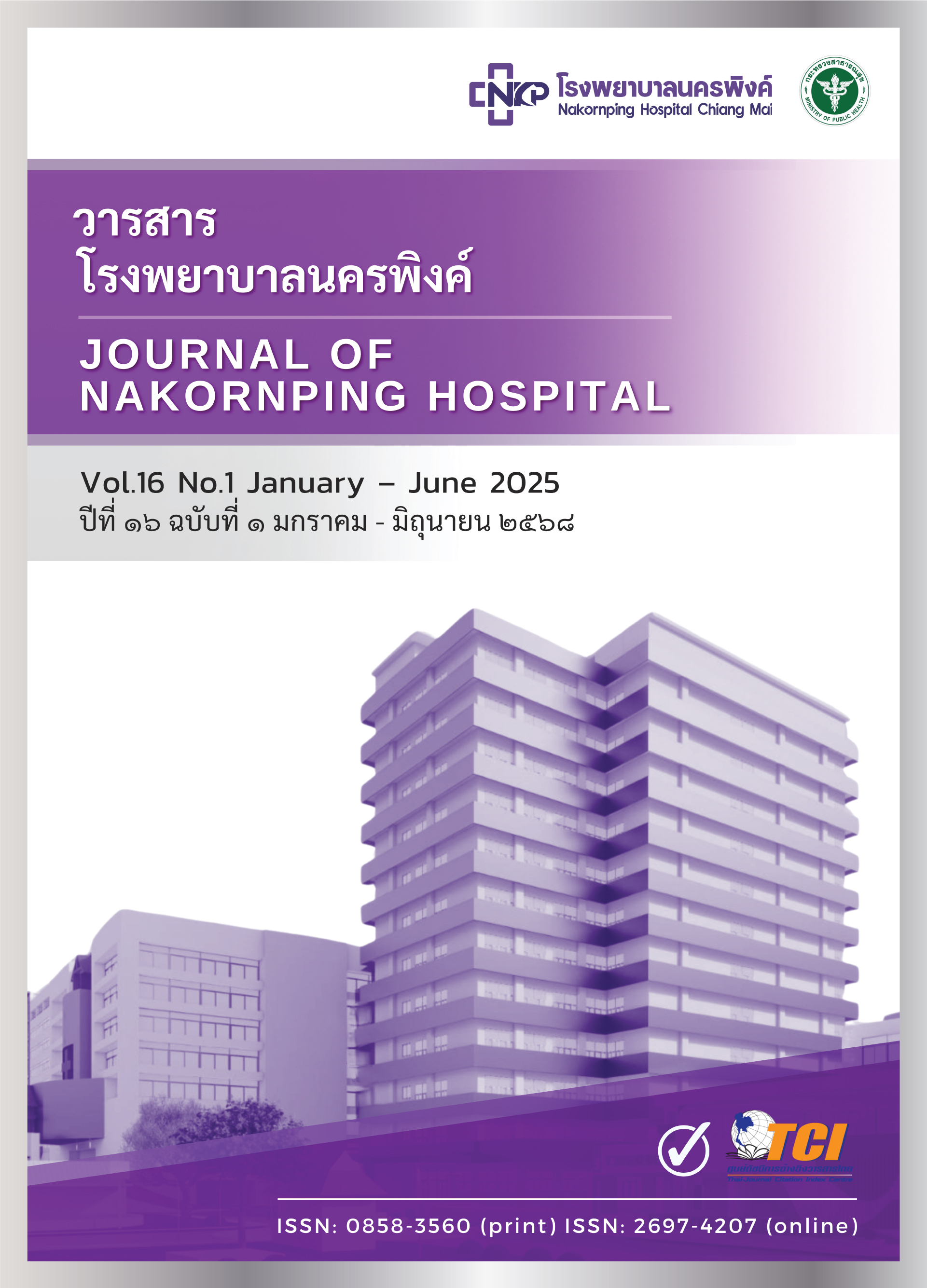Efficacy and safety of percutaneous nephrolithotomy using the Triangular technique, accessing the upper pole of the kidney through a subcostal incision for urinary tract stone removal
Keywords:
percutaneous nephrolithotomy, PCNL, kidney stones, percutaneous nephsubcostal access with Triangular technique, pleural injuryAbstract
This study aimed to evaluate the efficacy and safety of percutaneous nephrolithotomy (PCNL) using the triangular technique with upper pole renal access through a subcostal incision.
Methods: A retrospective cohort study was conducted on patients diagnosed with kidney stones who underwent treatment at Nakornping Hospital between January 28, 2020, and December 12, 2023. The study focused on patients who underwent percutaneous nephrolithotomy (PCNL) using the Triangular technique, in which access was gained through the upper pole of the kidney via an incision below the costal margin. Data were collected on stone-free rates, pleural injury, postoperative blood transfusion, postoperative fever, length of hospital stay, and operative time. Descriptive statistics were used for data analysis, and stone-free rates were compared using logistic regression.
Results: A total of 106 patients met the inclusion criteria, of whom 69 (65.1%) were male. The mean age was 55.83 ± 11.76 years, with an average body mass index (BMI) of 24.48 ± 3.88 kg/m². The mean stone surface area was 905.16 ± 553.17 mm². The average operative time for PCNL was 51.31 ± 4.44 minutes, and the mean length of hospital stay was 6.05 ± 1.93 days. The stone-free rate, defined as complete stone clearance or residual fragments ≤4 mm, was 73%. Postoperative complications occurred in 13 patients (12.26%), with no cases of pleural injury. Factors associated with incomplete stone clearance included a stone surface area of ≥800 mm² (OR 6.747, 95% CI 2.304–19.757, p < 0.001) and a Guy’s Stone Score (GSS) of 4 (OR 6.00, 95% CI 2.312–15.574, p < 0.001).
Conclusion: PCNL using the triangular technique with upper pole renal access through a subcostal incision is an effective and safe surgical method for renal stone removal. The procedure demonstrated high efficacy, no pleural injuries, and acceptable complication rates.
References
National Health Security Office. Nationwide statistics on urinary stone disease in Thailand, 2018–2023 [Internet]. Bangkok: NHSO; c2023 [cited 2024 Mar 16]. Available from: https://drive.google.com/file/d/120neMcJ7c58NE9o68eKv2xqFhVeq7L5J/view?usp=sharing [In Thai]
Nakornping Hospital. Strategic plan development meeting information for Nakornping Hospital, July 31, 2024 [Internet]. Chiang Mai: Nakornping Hospital; c2024 [updated 2024 Jul 31; cited 2024 Oct 25]. Available from: https://drive.google.com/file/d/1FhYt59Low4o68K_ZyxgAwT0zYNQeIqdm/view?usp=sharing [In Thai]
Sabler IM, Katafigiotis I, Gofrit ON, Duvdevani M. Present indications and techniques of percutaneous nephrolithotomy: What the future holds?. Asian J Urol. 2018;5(4):287-94. doi: 10.1016/j.ajur.2018.08.004.
Michel MS, Trojan L, Rassweiler JJ. Complications in percutaneous nephrolithotomy. Eur Urol. 2007;51(4):899-906. doi: 10.1016/j.eururo.2006.10.020.
Singh V, Garg Y, Sharma K, Sinha RJ, Gupta S. Prospective randomized comparison between superior calyceal access versus inferior calyceal access in PCNL for inferior calyceal stones with or without pelvic stones. Urolithiasis. 2016;44(2):161-5. doi: 10.1007/s00240-015-0805-1.
Ali M, Naeem Q, Zafar U, Abbas A, Muhammad F, Naqash M, et al. Outcomes and Complications of Percutaneous Nephrolithotomy (PCNL): A Single-Center Experience. Cureus. 2024;16(9):e69567. doi: 10.7759/cureus.69567.
Huang T, Jiao BB, Luo ZK, Zhao H, Geng L, Zhang G. Evidence of the outcome and safety of upper pole vs. other pole access single puncture PCNL for kidney stones: which is better?. Eur Rev Med Pharmacol Sci. 2023;27(10):4406-20. doi: 10.26355/eurrev_202305_32446.
Lojanapiwat B, Prasopsuk S. Upper-pole access for percutaneous nephrolithotomy: comparison of supracostal and infracostal approaches. J Endourol. 2006;20(7):491-4. doi: 10.1089/end.2006.20.491.
Altunrende F, Tefekli A, Stein RJ, Autorino R, Yuruk E, Laydner H, et al. Clinically insignificant residual fragments after percutaneous nephrolithotomy: medium-term follow-up. J Endourol. 2011;25(6):941-5. doi: 10.1089/end.2010.0491.
Thomas K, Smith NC, Hegarty N, Glass JM. The Guy's stone score--grading the complexity of percutaneous nephrolithotomy procedures. Urology. 2011;78(2):277-81. doi: 10.1016/j.urology.2010.12.026.
Gunawan S, Birowo P, Fadilah RN, Atmoko W. Outcome and safety of upper pole versus non-upper pole single puncture PCNL for staghorn stones: a systematic review and meta-analysis. F1000Research. 2019;8:537.
Munver R, Delvecchio FC, Newman GE, Preminger GM. Critical analysis of supracostal access for percutaneous renal surgery. J Urol. 2001;166(4):1242-6.
Türk C, Knoll T, Petrik A, Sarica K, Straub M, Seitz C. European Association of Urology guidelines on urolithiasis. Eur Urol. 2015;69:468.
Abdel-Khalek M, Sheir KZ, Mokhtar AA, Eraky I, Kenawy M, Bazeed M. Prediction of success rate after extracorporeal shock-wave lithotripsy of renal stones--a multivariate analysis model. Scand J Urol Nephrol. 2004;38(2):161-7. doi: 10.1080/00365590310022626.
Omer Rashid A, Khalid H, Friad G, Hamed RY, Buchholz N. Guy's Stone Score as a Predictor for Stone-Free Rate and Complications in Percutaneous Nephrolithotomy: A Single-Center Report from a Stone Belt Country. Urol Int. 2020;104(9-10):746-51. doi: 10.1159/000506211.
Downloads
Published
How to Cite
Issue
Section
License
Copyright (c) 2025 Nakornping Hospital

This work is licensed under a Creative Commons Attribution-NonCommercial-NoDerivatives 4.0 International License.
The articles that had been published in the journal is copyright of Journal of Nakornping hospital, Chiang Mai.
Contents and comments in the articles in Journal of Nakornping hospital are at owner’s responsibilities that editor team may not totally agree with.


